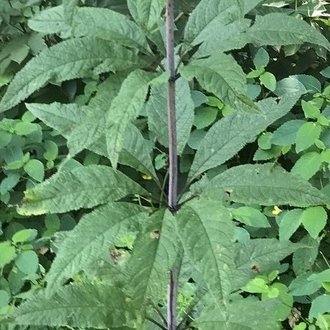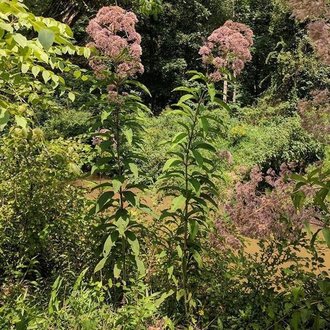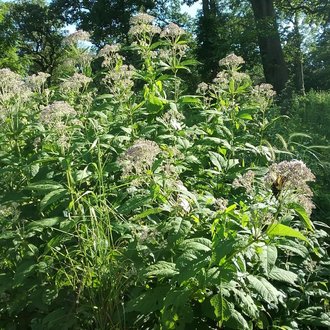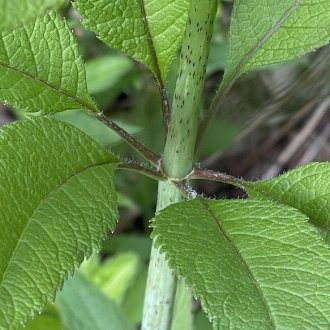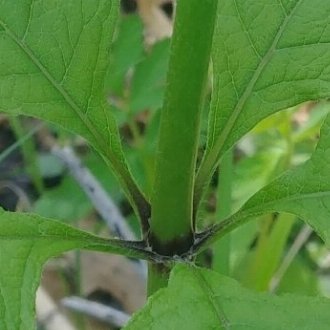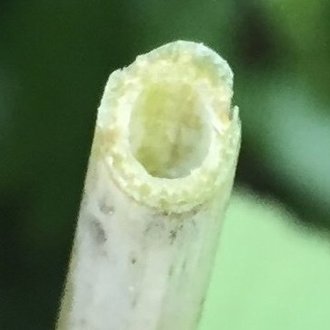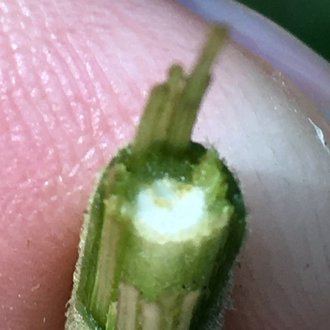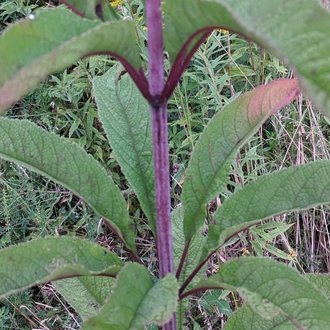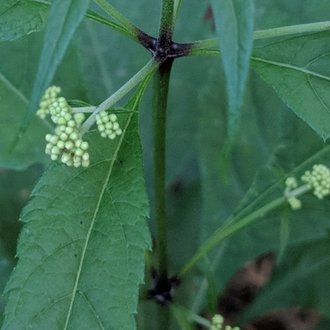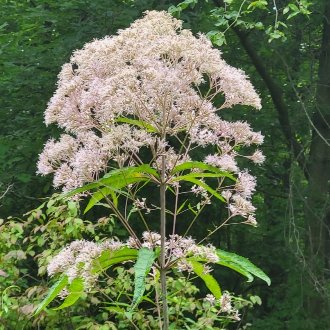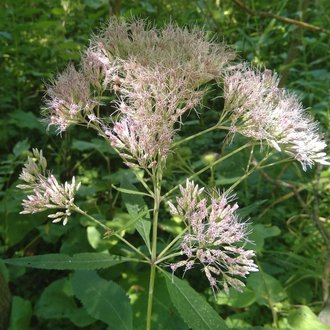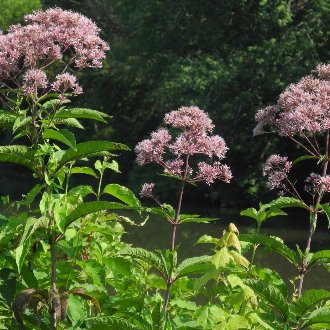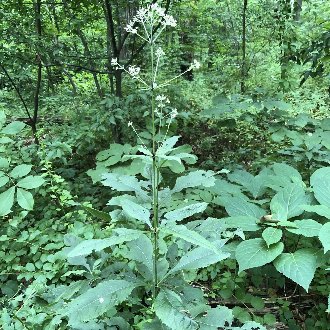Hollow Joe Pye Weed vs Sweetscented Joe Pye Weed
These species are frequently confused where their ranges overlap in the eastern and lower Midwestern U.S. Although they can occur relatively near each other on the same site, they have mostly non-overlapping habitat preferences. They can usually be distinguished by characteristics of their stem, and often also by their height, inflorescence shape, and number of leaves per whorl. E. purpureum ranges farther north and northwest, and occurs in drier, shadier, better-drained habitats. E. fistulosum ranges farther south and prefers moister, sunnier, more disturbed habitats, and is more tolerant of flooding and waterlogged soils.
Hollow Joe Pye Weed (Eutrochium fistulosum) | Sweetscented Joe Pye Weed (Eutrochium purpureum) |
A tall perennial of moist, rich, disturbed sites, native to the eastern U.S.; the tallest Eutrochium. | A tall perennial of partly-shaded areas, preferring drier and shadier conditions than other Eutrochium species. |
Leaves of mature plants usually in whorls of 4-7, occasionally 8. Seedlings begin with opposite leaves and young plants may temporarily have only 3 leaves per whorl. Photo © Mason Heberling, CC BY 4.0. | Leaves of mature plants usually in whorls of 3-4, occasionally 5. Seedlings also frequently have opposite leaves. Photo © megachile, Public Domain. |
Averages much taller, to 11.5 feet. Photo © Nate Martineau, CC BY 4.0. | Averages shorter, to 6.5 feet. Photo © Mary Crickmore, Public Domain. |
Early in the season, stems usually have subtle spotting and are glaucous, with a pronounced pale waxy coating. Although petioles (stems of individual leaves) may be purple, the stems themselves are not usually darker purple at the node than throughout. Photo © Summit Metro Parks, CC BY 4.0. | Early in the season, stems usually lack spotting, and are not glaucous. Stems usually have some bold purple at the nodes, contrasting with green color throughout. Photo © Katie Kucera, CC BY 4.0. |
The broader portion of mature stems are hollow, with a large central cavity. Photo © Ken Kneidel, Public Domain. | Stems tend to be narrower and are usually not hollow, instead filled with pith. If they are hollow, they have only a narrow central cavity. Photo © Becky, Public Domain. |
Stems late in the season are often purple throughout. These stems occasionally have some remnant spotting, and are sometimes still glaucous (with a pale waxy coating.) Photo © Lydia B, CC BY 4.0. | Stems late in the season are mostly green, but purple at the nodes, with purple extending onto petioles of adjacent leaves. Late-season stems are also not glaucous and usually lack spotting. Photo © Mirko Schoenitz, Public Domain. |
Inflorescence is denser, more rounded, dome-shaped on top, and extending farther down the stem, often leading the whole inflorescence to be taller than wide. Color averages more pinkish (but color alone is not reliable for ID.) Photo © Beepman, CC BY 4.0. | Inflorescence is looser and more open, more squarish on the edges, and not extending as far down the stem, leading the whole inflorescence to be wider than tall. Color averages paler (but color alone is not reliable for ID.) Photo © Marilynn Miller, CC BY 4.0. |
Occurs in sunnier, wetter, more disturbed habitats, such as floodplains, roadside ditches, and clearings in open bottomland woods. Photo © mjpapay, CC BY 4.0. | Occurs in drier, shadier habitats, typically in small clearings in rich mesic woodlands. Photo © Sus scrofa, CC BY 4.0. |
Additional Notes
The physical characteristics of these two species are adaptations to their respective habitats. Understanding these adaptations can help to remember both how to identify each species, and understand which habitats they occur in.The hollow stems of E. fistulosum allow it to reach greater heights while minimizing its resource expenditure, and is shared by a number of other tall herbaceous plants found in disturbed bottomlands, such as bamboo, pokeweed, and poison hemlock.
The height of E. fistulosum is an adaptation to its habitat, where an abundance of moisture, nutrients, and sunlight creates heavy competition from other tall herbaceous plants. The drier, more shaded habitat of E. purpureum has more moderate (still significant) competition from slightly shorter herbaceous plants, so the plant needs less height to be competitive. These forested habitats also tend to be more sheltered from wind, so the thinner stem is sufficient.
The sparser inflorescence of E. purpureum reflects the lower light availability in its habitats. The paler color of its flowers is also typical for summer-blooming plants in forests and may be better for attracting pollinators in these habitats.
The whorled leaf arrangement of this genus is an adaptation much like compound leaves, which serves to reduce drag, which can be an adaptation both for reducing water loss through wind drag, and leaf loss or other damage during floods with fast-moving water. The leaf shape and arrangement of E. purpureum, with fewer, broader leaves, is better for optimizing light capture in a lower-light environment, whereas on E. fistulosum, the more numerous, narrower leaves capture less light in a high-light environment, but are better at reducing drag. As this plant grows in floodplains and ditches, it is often exposed to fast-moving floodwaters, but it can also be subjected to periods of drought if water levels along streambanks or in wetlands fall during dry spells, and its habitats tend to be more open and exposed to wind, which can amplify drought stress. Its leaf arrangement thus also serves to protect the plant from drought stress.
References & External Resources
These short lists show only links helpful for ID. For a complete list of references and resources also covering other aspects of ecology, visit the links section of the full article on each plant, which is the first entry here.



